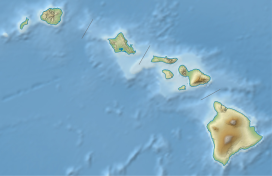Mānana
| Mānana | |
|---|---|
 Mānana Island (and Kāohikaipu) as seen from Oahu | |
| Highest point | |
| Elevation | 110 m (360 ft) |
| Prominence | 110 m (360 ft) |
| Coordinates | 21°19′52″N 157°39′32″W / 21.33111°N 157.65889°W |
| Geography | |
| Geology | |
| Mountain type | Tuff cone |
| Last eruption | Less than 200,000 years ago |
Mānana Island is an uninhabited
Waimānalo plantation.[2]
The rabbits were eradicated about a hundred years later because they were destroying the native ecosystem, an important seabird breeding area.
Mānana is a tuff cone with two vents or craters. The highest point on the islet rises to 361 ft (110 m). The island is 2,319 ft (707 m) long and 2,147 ft (654 m) wide and has an area of about 63 acres (25 ha). Mānana's only sand beach is a small storm beach on the west to south-west (leeward) side of the islet. This sand deposit, located above the reach of the normal waves, is about 30 ft (9.1 m) wide and curves around to the western side of the island. Another volcanic islet named Kāohikaipu sits right next to Mānana.
Manana was formed by the
Honolulu Volcanic Series. These series of eruptions were responsible for creating other tuff cones such as Punchbowl Crater
.
Mānana is a State Seabird Sanctuary—home to over 10,000
Hawaiʻi Department of Land and Natural Resources.[3]
References
- University of Hawaii Press. Retrieved November 27, 2010.
- University of Hawaii Press. Retrieved November 27, 2010.
- Hawaiʻi Department of Land and Natural Resources. Archived from the original(PDF) on May 17, 2011. Retrieved November 27, 2010.
External links
 Media related to Mānana at Wikimedia Commons
Media related to Mānana at Wikimedia Commons


